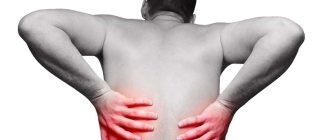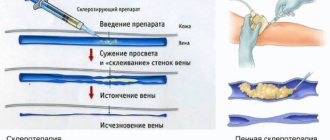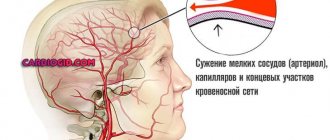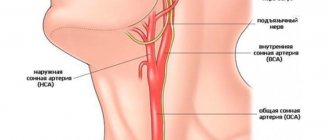Neurogenic dysfunctions occur regularly in patients. The number of sufferers, according to statistical estimates, is more than 30% of the people on the planet.
For the most part, these are relatively mild deviations from the norm, which are not even always noticeable, up to a certain point.
Numbness of the face is one of the possible neurological symptoms of diseases of the musculoskeletal system, processes in the brain, blood vessels of the neck and other structures.
The symptom is diverse and is present in a large number of pathological processes. The cause of the deviation can be identified through instrumental diagnostics.
In some cases, sensory loss indicates an emergency condition, such as a stroke. Therefore, when such a symptom develops, especially if it is combined with paresis or paralysis, an ambulance must be called to exclude necrosis of cerebral structures.
Therapy depends on the case. Numbness itself does not require correction; it is necessary to influence the provoking factor. This is the basis.
Migraine
It is still considered a mysterious disease. Mainly found in women, the ratio of the number of patients m/f can be determined as 3:1 and even more.
It has a clear hereditary nature, if one of the parents had a disorder, with a probability of over 70% the disorder is transmitted to children and manifests itself at some point.
Why migraine develops is not known for certain. It is assumed that the disorder is caused by spasm of cerebral vessels against the background of autonomic dysfunction. That is, we are talking about a purely neurological disease, but whether this is true or not is a moot point.
The symptomatic complex is always approximately the same. In classic cases, the following signs of the condition are found:
- Severe headache. On the one side. Left or right. Baling, shooting, bursting. Accompanies the patient throughout the entire episode of the disorder. It radiates into the orbit and can move towards the crown and back of the head, initially located in the frontal region.
- Nausea, rarely vomiting.
- Disorientation in space. A person cannot move normally, the world is spinning and spinning before his eyes.
- Numbness of the entire head or part of the face as a result of a disorder of nerve conduction at the level of cerebral structures. This is a temporary phenomenon that does not indicate either the severity of the problem or the likelihood of a favorable outcome.
Migraine as such is not dangerous, but it is an extremely uncomfortable condition. However, the symptoms can often resemble a stroke, so if suspicious signs develop, it is recommended to call an ambulance.
Pre-stroke symptoms are described in detail in this article.
In atypical situations, there may be no headache with the predominant preservation of the aura - manifestations preceding a migraine attack. Decreased visual acuity, hearing, intolerance to bright light and sound, flickering of flies, the appearance of flashes in the field of view, and others.
Against this background, numbness of the face is also an integral part of the initial manifestations, even outside the pain syndrome.
Diagnostics
In case of numbness of the face once, there is no need to worry too much. It is important to exclude the cause of such a symptom and forget about this trouble forever. If the problem recurs, this signal from the body should never be ignored. You should immediately visit your doctor and rule out possible serious illnesses. The doctor collects an accurate medical history and, based on the patient’s complaints, prescribes the necessary tests:
- General blood analysis.
- Ultrasound of cerebral vessels.
- MRI.
- X-ray of the skull.
In addition, the patient needs examination of the nasopharynx and consultation with a neurologist.
The results of tests and studies make it possible to determine the cause of facial numbness and begin proper treatment.
Osteochondrosis
It is an inflammatory, degenerative-dystrophic disorder of the spine, in particular, the cervical region suffers.
The pathology develops and progresses gradually and steadily. Detecting the moment when the disorder reaches a dangerous level is not easy.
Neurological symptoms, such as impaired facial sensitivity and others, also do not develop overnight, over many years.
Signs are specific:
- Pain in the neck area. Popping, burning or bursting. Fickle. Intensifies after physical activity.
- Dizziness. Accompanied by the inability to navigate in space. Develops sporadically.
- Cephalgia. Pain in the back of the head, crown.
- Problems with motor activity of the cervical spine. It is impossible to turn, motor abilities decrease gradually but steadily.
- Numbness of the face, lips, tongue and head with osteochondrosis is common, along with a decrease in sensitivity in the hands. This is a late sign. In the initial phase, it is present when the nerve endings are pinched, then, when the roots die, it remains permanently.
- Nausea. Vomiting is less common.
- Problems with cardiac activity. Like tachycardia. Relatively rare.
Disruption of the musculoskeletal system provokes characteristic manifestations due to compression of nerve endings at the local level.
It is necessary to differentiate from hernias of the cervical spine. As a rule, both processes occur in parallel.
Provoking factors
What causes numbness in facial skin? The reasons for the appearance of unpleasant sensations are very different. Among the most common are diseases of the nerves or blood vessels that pass through this area. If the condition spreads to other areas of the body, a specialist may assume that the problem is in pathologies of the central nervous system. Facial numbness often appears as a symptom of the disease. There are several pathologies that are characterized by the occurrence of paresthesia. The most popular include:
- Bella's palsy. This disease appears as a result of a viral infection (herpes, meningitis and others). It provokes an inflammatory process in nerve fibers. This, in turn, entails numbness of the skin of the face, lips and tongue.
- Cervical osteochondrosis. This disease is one of the most common causes of paresthesia. Decreased sensitivity and discomfort in this case are a consequence of constant compression of the vessels and nerves of the spine by accumulated salts. In this case, numbness of the facial skin is accompanied by pain in the cervical region, ailments, and crunching of the vertebrae when the neck is turned.
- Multiple sclerosis. This is an autoimmune disease in which the body's immune cells begin to attack and damage the nerves. This results in the destruction of the protective sheath of the fibers (myelin). Due to these injuries, numbness of the face, paresthesia of the neck, and limbs appear.
- Damage to the trigeminal nerve. Neuralgia develops due to irritation or compression of fibers outside or inside the skull. This occurs due to adhesions after expansion of the cerebellar arteries or veins, injuries, inflammatory processes in the area of the oral or nasal cavity. Against the background of pathology, numbness is not the only symptom. At the same time, the patient feels severe pain around the ears, eyes and nose.
- Pinched nerves. In this case, we are talking about damage or irritation of the maxillary or mandibular or optic nerves. As a result, sensitivity is impaired, which, in turn, manifests itself in the form of numbness.
- Shingles. This pathology is accompanied not only by paresthesia. Tingling and loss of sensitivity are accompanied by itching and rash in the face, headache, chills and fever.
Hernias of the cervical spine
A dangerous complication of osteochondrosis. Less commonly it develops as a result of injury or sudden movement. For example, after a car accident, an unfortunate fall, a fracture, etc.
The essence of the disorder is the displacement of the intervertebral disc beyond its normal anatomical position. Then it breaks and completely loses its own structure and function.
This leads to abrasion and degeneration of adjacent vertebrae and even greater limitation of activity and severe discomfort.
The clinical picture is typical. Disorders of the musculoskeletal system are accompanied by severe, sometimes unbearable pain in the neck (in an acute state they do not go away at all), problems with orientation in space.
The patient cannot hold his head up because the muscle corset is weak.
In almost 100% of cases, a clinical picture of vertebrobasilar insufficiency is detected; due to instability of the spinal column, compression of local arteries occurs.
The therapy is surgical, but doctors are delaying the moment as best they can. They stop attacks and prevent new ones.
Numb hands keep you from sleeping
Even healthy people can get numb hands during sleep: by placing their left or right hand under their head and deeply immersed in the world of dreams, a young body can sleep through the night without ever turning over to the other side. Moving the limb and lightly rubbing it quickly returns it to normal and the unpleasant sensations are forgotten. It’s another matter when your hands systematically go numb at night, when a tingling feeling appears in the daytime, when others are added to this symptom: pain, weakness, cramps. There are different options for numbness of the upper extremities, each of which may indicate a specific pathology:
diagram of the nerves of the hand, compression of which is possible due to osteochondrosis and other reasons
- Your hands go numb at night, and during the day you suffer from pain in the head, neck, back (and periodic numbness if you stay in one position for a long time) due to osteochondrosis of the cervical spine and herniated intervertebral discs;
- The cause of numbness in the thumb may be a hemangioma or neurofibroma , which compresses the nerve endings, as well as a compressive effect on the median nerve passing through the carpal tunnel (carpal tunnel syndrome). Meanwhile, if the thumb “does not come to its senses” for half an hour or more, you should not postpone a visit to the doctor, otherwise its muscles may even atrophy;
- ulnar nerve neuropathy occurs . Some patients may not even know that they have this pathology. The disease develops imperceptibly in those people who are forced to rest their elbow on a hard surface for a long time and thus compress the ulnar nerve (a computer desk, for example), moreover, right-handed people often put stress on their right hand, and in left-handed people their left hand goes numb;
- Hands go numb at night, there is pain in the hand, fingers become “wooden” (one or 4, because the little finger is not involved here) in case of median nerve neuropathy or carpal tunnel syndrome . The most likely cause of pathological changes may be old bruises and fractures, as well as inflammatory processes localized in this area (arthritis and arthrosis). Often a similar picture is caused by edema caused by pregnancy or decreased thyroid function (hypothyroidism);
- The symmetry observed in numbness of the fingers and hands is characteristic of polyneuropathy (a complication of diabetes mellitus). By the way, with polyneuropathy, not only the fingers of the upper extremities suffer; the toes often go numb, and, in addition, the surface of the foot can be affected anywhere with the development of the corresponding syndrome.
vascular causes of numbness - spasm or damage to arteriolesThey lose their natural color (turn white or blue), become cold to the touch, and the fingers hurt and go numb when blood circulation in the microvasculature is impaired, caused by a sharp spasm of blood vessels. This occurs most often in Raynaud's disease and scleroderma ;
- It should be noted that chronic alcoholism and severe poisoning also contribute to the appearance of signs of polyneuropathy, namely, numbness of the fingers and toes during sleep and in reality;
- Of particular concern are cases when only the left hand and, especially, its thumb are numb, which is most often associated with the development of atherosclerosis, cardiac pathology, osteochondrosis of the cervical and/or thoracic spine. But if the loss of sensation in the thumb of the left hand mainly suggests diseases of the cardiovascular system, then numbness and other symptoms regarding the right hand are perceived as a suspicion of cervical spondylosis, which, however, does not affect young people;
- Heart problems by numbness in the little finger of the left hand, and if it stops showing “signs of life” together with the ring finger, then it is time for the patient to think about a visit to a cardiologist.
If both arms go numb at the same time or an unpleasant tingling sensation is localized in a specific area of the left or right arm, or affects the hands or fingers, and the clinical picture is diluted by additional symptoms (weakness, pain, numbness of other parts of the body), the thought of development of the above-mentioned serious diseases (multiple sclerosis, neoplastic process). If this happens suddenly, then a TIA or stroke can be suspected.
Looking for a reason
Each person has pain and numbness in his own way and, probably, not all options for numbness in the fingers have been considered, however, if stiff limbs are increasingly waking you up at night, and a person cannot find an explanation for this, then perhaps a short list of reasons will help him that cause these unpleasant sensations:
- Professional activity;
- Osteochondrosis of the cervical and thoracic spine;
- Intervertebral hernia;
- Iron deficiency in the body;
- Endocrine diseases;
- Inflammation of the pancreas;
- Pathological changes in joints;
- Venous stagnation;
- Arterial hypertension;
- Sharp spasm of microcirculatory vessels;
- Polyneuropathy.
In addition, to determine the true cause of hand numbness, you should pay attention to other symptoms that accompany these unpleasant, and sometimes painful, episodes:
- Weakness of the hand;
- Low contractility of the muscular system;
- Possible pain in the shoulder and forearm;
- Fatigue, malaise, bad mood;
- Dizziness;
- Heaviness in the head, noise in the ears;
- Inconsistency of movements;
- Unstable blood pressure (jumps and falls);
- Impaired functioning of the vestibular apparatus;
- Flashing "flies" before the eyes.
Some of the listed diseases and their symptoms can cause your toes to go numb, so it’s time to talk about this too.
Video: hand numbness
Video: 3 reasons for hand numbness in the “Live Healthy!” program
Vertebrobasilar insufficiency
A common disorder. Usually develops as a complication of osteochondrosis of the cervical spine.
The essence of the disease is a sharp disruption in the nutrition of cerebral structures due to compression of the arteries localized in the neck.
There are many variants of the clinical picture of the disease. Basically, the symptomatic complex comes down to a group of deviations:
- Headache. Expressed, strong. Migraine attacks are possible during the course of the disease.
- Dizziness and inability to navigate in space. The person is in a forced position. Lying on his side, he moves little.
- Nausea, vomiting.
- Visual impairment. Loss of areas of visibility, sensation of bright flashes (simple hallucinations), temporary total blindness is possible. In late, advanced stages.
- Decreased hearing acuity.
- Inability to move smoothly. Unsteadiness of gait. This is all due to disruption of the extrapyramidal system.
- When the lobes of the brain on the left side are affected, the right side of the head (and the body in general) goes numb and vice versa.
Also other clinical signs. VBI is considered a significant factor in the development of stroke in the future. The cerebellum and occipital region of the brain are affected.
With timely treatment, it is possible to stop the progression of the disease and take control of the situation.
Causes of the phenomenon
Hypesthesia of the head on the right side is associated with the following reasons:
- Mechanical damage to the head or neck. Bruises of the skull are accompanied by dizziness, nausea, and double vision. Symptoms of injuries may appear immediately or after 1-2 days.
- Migraine. Severe pain, which often spreads to the temporal region, can cause numbness of the head on the right.
- Multiple sclerosis. This is a progressive disease of the central nervous system, in which individual areas of nervous tissue are replaced by connective tissue. This causes hypoesthesia in different parts of the body and head.
- Impaired blood flow in the vessels of the brain. The phenomenon is often observed in patients over 60 years of age. Those at risk are those who suffer from obesity and cardiovascular diseases.
- Development of neoplasms in the head area. As the tumor gradually grows, compression of the skull occurs. This causes hypoesthesia, pain, and loss of coordination.
- Vegetative-vascular dystonia. The disorder causes short-term numbness in different parts of the body.
- Inflammation of the trigeminal or facial nerve. Part of the head and half of the face go numb.
Numbness of the head on the right indicates disorders in the left hemisphere of the brain, and vice versa.
The described symptom is a variant of the norm. Causes of the phenomenon: an uncomfortable position in sleep, which caused a temporary disruption of blood circulation or nerve compression, overwork, emotional stress, a sharp turn of the neck to the side.
↑
Cluster headaches
An extremely rare neurological condition. However, it is very difficult. Accompanied by unbearable, painful attacks of discomfort in the frontal region.
Unpleasant sensations radiate to the eyes. The clinical picture is complemented by pronounced numbness on the left side of the face or vice versa, depending on the exact localization of vascular spasm.
The etiology of the disease is unknown. It is believed to be a related condition to migraine, with some differences.
A typical symptom is a severe headache that cannot be relieved by any medications. The intensity of the discomfort is so great that suicide attempts are known among patients during an attack.
Treatment is not possible; the only thing doctors seek is to prevent relapses in the future. Reducing the risks of developing such.
Causes of facial numbness
There are many reasons why facial numbness occurs. It is sometimes difficult to figure this out on your own. Numbness of a part of the face can occur either due to pathological diseases or without them.
It is worth listing the reasons that are not related to diseases:
- Great excitement. Many people have more than once noticed a tingling sensation on their face, numbness in their cheeks or lips during a serious quarrel. This symptom is caused by excessive contraction of the jaw muscles in a fit of anger. The same reaction can occur in a person when he laughs long and hard.
- Fear. Usually in such cases there is numbness of the jaw. This is caused by rapid breathing and muscle spasms due to nervousness.
- Squeezing of blood vessels. This happens if a person rests his chin on his hand for a long time. In such cases, the left side of the face usually goes numb if the hand is on the left side and vice versa if it is on the right. This malaise does not extend to another area. After warming up and changing positions, everything goes away.
- Inconvenience when resting at night. If facial numbness is often observed after waking up, then the reason lies in how and in what position the person sleeps at night. Inconveniences during night sleep associated with an incorrectly selected pillow or position lead to impaired blood circulation in muscle tissue. Changing your pillow and sleeping position helps get rid of the problem literally the next morning.
- Staying in one position for a long time. This problem most often worries office workers and those who have been accustomed to watching TV for a long time without rest. In such cases, people notice how their cheek or chin goes numb. This occurs due to circulatory problems. To prevent such discomfort from bothering you, it is important to take a warm-up break at least every 45 minutes.
- Taking some medications can cause facial numbness. This is usually written in the instructions for the medicine. After completing the course of treatment, the discomfort goes away.
All of the above reasons that a person complains of facial numbness are not terrible. With a change of environment and some adjustments in life, everything gets better, and the problem goes away.
If the situation repeats periodically, but the person’s emotional state is stable, he adheres to all recommendations regarding comfort during work and sleep, and his face becomes numb for an unknown reason, it is important to take this signal from the body into account and exclude possible diseases.
Among the causes associated with diseases, it is worth highlighting the following:
- Neuralgia, with damage to the ternary nerve. This disease is characterized by numbness of the cheek and chin. This pathological process may be a consequence of inflammatory processes such as sinusitis or sinusitis.
- Migraine. With this pathological disease, which affects the vascular system, a person feels that half of his face is numb. This ailment haunts those who complain of frequent headaches.
- Neuroses, depression, increased excitability. Numbness on the left or right side of the face is felt by people who have become very worried at some point. In the future, similar symptoms can be observed even without the factor that provoked the first attack.
- Problems with blood supply to the face. In this situation, the right or left side of the face becomes numb. At first glance, the pathology may seem harmless. But it is precisely this that can subsequently cause a stroke.
- Osteochondrosis. This disease is characterized by constant malaise. The patient often feels dizzy. In addition, a crunching sound is heard when turning it. Most often, with osteochondrosis, numbness of the entire face is observed. Less often, this malaise is observed on one side.
- Stroke. This disease causes the sensation of goosebumps on the face. Only after this does the patient complain that his face is numb. In this situation, delay can have serious consequences. Every minute counts. The patient should be immediately admitted to the hospital.
- Nerve palsy. In most cases, the disease appears due to infectious exposure. For example, this is observed in patients with meningitis or viral herpes. This pathological illness is most often accompanied by a feeling that the nose is numb. In rare cases, the numbness spreads to other facial muscle tissues and the patient complains of numbness in the cheek or other areas of the face.
- Lichen. This disease has the main symptoms in the form of rashes and skin itching. In addition, they are accompanied by numbness of part of the face.
People who want to understand the reason why the forehead or other part of the face is numb should understand that if serious pathological processes are excluded, the cause may lie in a common malaise. Many people who have suffered a serious illness and are deficient in B vitamins, potassium and other beneficial minerals can experience all the unpleasant moments of such an ailment. Everything goes away after taking special vitamins and mineral supplements.
Transient ischemic attack
A common phenomenon. It is mistakenly called a microstroke. In fact, we are talking about an acute but temporary disruption of brain nutrition. Develops as a precursor to an emergency condition.
The main patient population is people with a history of arterial hypertension, often elderly.
The clinical picture is identical to that of a typical stroke. The only difference is the duration of the violation and its outcome.
Transient ischemia does not lead to necrosis of nerve tissue; moreover, it regresses spontaneously, independently, even without the help of a specialist. If I may say so, this is a rehearsal for a stroke.
Among the manifestations:
- Severe headache in one area or another. Bursting, baling. Intense.
- Disorientation in space.
- Nausea, vomiting.
- Discomfortable sensations on the skin: goosebumps, tingling. A typical patient complaint is that half of the face or arm is numb. This is an indication of a disruption in the conductivity of nerve endings, but not the death of them.
- Confusion.
- Dysfunctions of the sense organs.
If your head goes numb, it could be a transient ischemic attack or a chronic brain disorder.
Differential diagnosis is mandatory. It is aimed at distinguishing between different conditions.
My legs are going numb
The presence of a certain pathology may also cause numbness in the toes. Numbness of the lower extremities accompanied by intense pain after physical activity is characteristic of vascular pathology, which leads to impaired circulation and damage to nerve tissue:
- Obliterating endarteritis (thromboangiitis obliterans, Buerger's disease);
- Trophic ulcer;
- Varicose veins;
- Thrombophlebitis;
- Thrombosis of blood vessels of the legs;
- Chronic venous insufficiency;
- Atherosclerosis of blood vessels of the lower extremities;
- Polyneuropathy;
- Diabetic foot syndrome, which, however, refers to the clinical manifestations of polyneuropathy, which is a complication of diabetes mellitus.
in case of numbness of the legs, a significant role, along with osteochondrosis, is played by vascular problems of the legs - affecting the arteries (in particular atherosclerosis - a) and veins (venous stasis coupled with varicose veins and CVI - b)
The toes also go numb with neuralgia of the sciatic nerve, which we call sciatica. The disease, as a rule, is accompanied by “lumbago” in the lumbar region and in the leg; it is often a consequence of pathological changes in the lumbosacral spine:
- Intervertebral hernia;
- Osteochondrosis of the lumbar region;
- Bruises, fractures and other traumatic injuries.
Pregnant women who have very little time left before giving birth often complain of numbness in their legs. Their lateral thighs are more likely to suffer. The cause of discomfort, in addition to the additional burden on the body, may be a deficiency of iron and other microelements. In this case, cramps and other symptoms may be added to the numbness.
Thus, various pathological conditions affecting nerves and blood vessels can cause numbness in the toes. And to complete the picture, let’s add some more diseases to the existing list:
- Diabetes;
- Exposure to low temperatures leading to frostbite;
- Raynaud's disease and syndrome;
- Tumors of peripheral nerves;
- Angiopathy of various origins;
- TIA (transient ischemic attack);
- Multiple sclerosis;
- Lower limb tunnel syndrome (tunnel neuropathy, nerve compression in the canal);
- Stroke and its younger “brother” (micro-stroke);
- Rheumatoid arthritis.
Of course, short-term pressure on a nerve (poor posture) and numbness in the toes is not a reason to immediately run to the doctor. You should think about it when tingling occurs frequently and is accompanied by other symptoms (pain, loss of sensitivity, loss of coordination of movements). And if a person cannot understand whether he has immersed his foot in water - cold or hot, a visit to the doctor should be urgent.
Stroke
Acute cerebrovascular accident. According to statistics, it is somewhat less common than a heart attack and is the second most important factor in deaths around the world.
The essence of the disorder is necrosis of cerebral structures. Nerve fibers die and irreversible changes occur in the brain.
The condition is extremely unfavorable in terms of its course; without medical care it leads to death.
Symptoms are divided into general and focal. The first includes headaches and spatial orientation problems. Nausea and vomiting. The second category is much more complex.
Possible deviations include:
- Confusion. Fainting conditions.
- Behavioral disorders, inappropriate emotional reactions or their complete disappearance.
- A sharp decline in cognitive and mnestic functions.
- Verbal hallucinations (auditory), epileptic episodes, deafness.
- Tactile disturbances. Damage to the parietal region is precisely the reason why the face goes numb. In addition, there is a loss of sensation in the limbs. Although not always.
- Decrease in visual acuity. Various visual disturbances.
In particularly difficult cases, there are also abnormalities in heart function and inadequate thermoregulation. These are critical disorders that are almost guaranteed to lead to the death of the patient.
Read more about the symptoms of stroke in women here, in men here. The first aid algorithm before the ambulance arrives is described in this article.
Why does your face go numb when you have a headache?
Decreased tissue sensitivity caused by an uncomfortable posture or prolonged stay in one position does not require treatment. Just wait a little and the symptoms will disappear on their own. To speed this up, you need to do a light massage of the problem area.
However, hypoesthesia of the head and neck does not always go away without any consequences; it can also be a symptom of a disease. If numbness occurs regularly and is accompanied by other clinical signs, such as fever, decreased hearing and vision, then the person may need to consult a neurologist, or a full examination.
Remember that it is better to prevent a problem than to get rid of many complications later. The following accompanying signs may indicate the danger of hypoesthesia:
- slurred speech;
- involuntary emptying of the bladder;
- unsteady gait, dizziness;
- disorders of the musculoskeletal system.
Based solely on the main and accompanying symptoms, it is difficult to determine what causes numbness of the scalp; the reasons can only be found out after examination and tests. In addition, sometimes diagnosis can be based on secondary symptoms. Numbness due to double vision and lack of coordination can be caused by:
- pinched nerve;
- injuries;
- multiple sclerosis;
- circulatory disorders in the brain;
- tumor.
Some severe conditions require urgent hospitalization, especially those caused by traumatic brain injury, which can cause bleeding in the brain. Particular danger lies in fractures of the cheekbones, eye sockets and upper jaw.
A concussion whose symptoms do not go away within a few days may also indicate a more serious brain injury that must be diagnosed.
Why does my head go numb?
Stroke is a serious acute condition that requires emergency medical care. Facial numbness may be the first sign of an onset
half of the body.
Sometimes trigeminal neuralgia manifests itself in the form of such symptoms.
Hypertensive crisis. Numbness of the face in this condition is most often associated with transient cerebrovascular accident.
Vegetative-vascular dystonia.
Migraine. In some patients, the face goes numb before an attack of headache - a peculiar manifestation of the aura.
Cervical osteochondrosis. Numbness of the face and headache have the same cause in cervical osteochondrosis - pinched nerve roots.
Neuroses, various mental disorders and diseases of the nervous system.
Often, when a patient comes to the doctor complaining that he has a headache and his face is numb, it is not possible to immediately understand the cause of this symptom. It is necessary to conduct a thorough examination and prescribe consultations with other specialists.
Most often, if one part of the head goes numb, this is not a symptom of any serious disease.
When a person discovers the first alarming symptoms that are repeated repeatedly, he thinks about what triggered them. Only a doctor can answer such a question. He must first conduct all the necessary examinations and only then accurately diagnose the presence of any disease.
A specific symptom is often accompanied by tingling of the lips or the entire face. Sometimes it is accompanied by swelling and a burning sensation in the tissues; control over the facial muscles may decrease or be lost. Serious diseases are diagnosed in 20% of cases when the symptom appears.
Many people ask the question of what to do if the face goes numb. Doctors call this condition paresthesia.
“Masha, why are you so scared, what happened?” asked the husband, entering the room. “Yes, you’ll get scared here, all of a sudden your face goes numb.
I just sat there with knitting needles in my hands, everything was fine. I saw you through the window, turned my head, and there was a crunch in my neck, and there was muteness in half my face.”
Strange, isn't it? But such cases are not rare, even among young women. Why the face goes numb and what to do about it is what we will talk about in this article.
The face goes numb - the reasons are illness
Usually, numbness on one side of the head is not dangerous and indicates that, for some external reason, blood circulation in the brain has been disrupted. However, you should be wary if it happens for no reason or lasts for a long time, or if attacks occur on a regular basis.
At risk are older people over 60 years of age, in whom this may be a symptom of a more serious brain disease, or indicate a circulatory disorder. If the left side of the head goes numb, it is usually harmless, but if the left half of the body is numb, this may indicate a stroke, then you need to urgently call an ambulance.
When do facial muscles hurt?
It is characterized by the development of purulent inflammation in the bones of the facial skull. Most often it is a complication of long-term caries, pulpitis, periodontitis. Pain in the bones of the face is accompanied by symptoms such as
bodies up to 38
C, malaise, weakness, swelling of the facial skin.
The most dangerous and severe of them is
base of the skull. The most common is a broken nose. For fractures of the facial bones, the following symptoms are noted:
- strong pain;
- swelling in the facial area;
- subcutaneous hemorrhages (with fractures of the base of the skull, hemorrhages around the eyes are most typical - the so-called “symptom of glasses”);
- discharge of clear fluid or blood from the ear;
- deformation of the nose due to fractures.
In this case, pain in the facial area is accompanied by
. Pathology can develop after
, transferred
Such pathologies are called
. They are caused by irritation of the nerve as a result of its compression by a tumor, an enlarged tortuous vessel, other pathological formations, as a result of the inflammatory process. Sometimes the causes of neuralgia cannot be determined.
The nature of facial pain differs depending on which nerve in the facial area is affected.
Facial nerve pain
The most typical disorder is the movement of facial muscles in one half of the face. In this case, the right or left side of the patient’s face seems to droop; there are no movements or facial expressions.
When laughing and expressing other emotions, the face becomes asymmetrical.
There is a widening of the palpebral fissure on the affected side, dryness of the eye (a symptom that is called lagophthalmos among neurologists).
Many patients report disturbances in the sense of taste.
In rare cases, neuritis of the facial nerve manifests itself in the form of severe pain in the face and ear, with the simultaneous appearance of herpetic rashes.
Diagnosis and treatment of neuritis of the facial nerve is carried out by a neurologist. 90% of patients ultimately recover completely, and all their symptoms disappear without a trace.
Trigeminal neuralgia
The trigeminal nerve is the main sensory nerve in the facial area. It has three branches: upper, middle and lower. The characteristics of the pain depend on which of the three branches is affected, and on the characteristics of its course and branches.
Source: https://novosibmemorial.ru/pochemu-nemeet-lico-pri-golovnoj-boli/
Infectious and inflammatory diseases of the brain
Among these, two can be named: meningitis and encephalitis. Both develop against the background of a previous disease (the focus does not matter), or after bites from vectors (for example, ticks).
They occur acutely and are accompanied by pronounced deficit neurological phenomena.
It is not always possible to determine the nature of the disorder even through MRI.
The only reliable diagnostic criterion is the presence of an infectious agent, possibly blood, in the cerebrospinal fluid.
Doctors obtain a sample through puncture. However, this is a dangerous procedure; it is used relatively rarely and only when necessary.
The clinical picture resembles that of a stroke, but the symptomatic complex develops less rapidly.
If help is not given in a timely manner, the disorders persist for a long period and cannot be corrected. Diseases can result in profound disability.
Multiple sclerosis
Common neurological disease. It is of autoimmune and metabolic origin.
Accompanied by destruction of the myelin sheath of nerve fibers. For this reason, the speed of impulse transmission drops, and then the possibility of this is lost completely. The disease affects the brain, less often the spinal cord.
Such degeneration progresses constantly, but does not lead to critical disorders at one point. This is a rather lengthy process. It takes more than one year before disability, often much longer.
Timely treatment can reduce symptoms and significantly slow down the pathological process.
The clinical picture is varied and depends on the location of the area of nerve fiber destruction. Typically, motor dysfunctions, a feeling of numbness of the face and limbs, decreased visual acuity, and cognitive disorders are detected.
Intelligence, however, suffers only slightly, at least in the early stages. Without treatment, there is a high chance of rapid disability.
Why do fingers and limbs go numb?
Normal sensitivity in the body is ensured by the well-functioning functioning of the sensitivity pathway. Sensory nerve endings - sensory receptors - transmit signals along a chain from the skin to the spinal cord, from the spinal cord to the brain stem and, finally, to the brain - the part of the brain that perceives the received signals.
If any disturbance occurs in one of the sections of the sensory pathway, numbness develops. Let's consider what disorders lead to numbness of the limbs.
Numbness of legs and arms
In addition to the sensory pathway, our body has special nodes - nerve plexuses, which can be compared to electrical distribution boxes. There are only 4 of them - cervical, shoulder, lumbar and sacral. The lumbar and sacral plexuses are responsible for the sensitivity of the legs, and the brachial plexuses for the sensitivity of the arms, so any damage to these nerve nodes can cause numbness in the lower and upper extremities.
Nerve nodes are affected due to many different reasons. The most common conditions that provoke loss of sensation in the legs and arms include:
- compression of nerves and nerve roots - intervertebral hernia, various forms of spondylolisthesis (vertebral displacement), trauma, pressure from a tumor;
- vascular pathologies - vasculitis, diabetic neuropathy, Raynaud's disease, strokes, transient ischemic attacks (“micro-strokes”), aneurysms;
- neuritis - inflammatory processes in nerve fibers caused by toxins, infection, severe hypothermia;
- autoimmune diseases – Guillain-Barré syndrome, systemic lupus erythematosus;
- tumors and other diseases of the brain, spinal cord, and other organs;
- toxic nerve damage – in the case of alcoholic polyneuropathy, heavy metal poisoning;
- side effects of treatment for viral diseases, as well as other medications or chemotherapy.
There are dozens of reasons that can lead to numbness of the body in the extremities, so in each individual case a deep diagnostic process is required.
Decreased or loss of sensitivity in the little finger
Numbness in the fingertips, as well as in the hand and entire right arm, may have a specific trigger called carpal tunnel syndrome, or carpal tunnel syndrome. This disease is caused by a pinched nerve in the bundle of carpal ligaments, bones and tendons located in the wrist. It is usually associated with the professional activity of a person who is forced to constantly perform flexion-extension movements of the hand, so it often affects:
- car assembly mechanics;
- pianists;
- drummers;
- bowlers;
- artists;
- sign language interpreters;
- webmasters and computer gamers who actively use a computer mouse.
Elderly and senile people are also prone to this symptom.
Hemorrhoids kill the patient in 79% of cases
In addition to numbness of the little finger and ring finger (which is especially typical for computer users), carpal syndrome may have other symptoms: shooting pain in the fingers, hand and entire limb, weakness, inability to hold even not too heavy objects in the hand (for example, a glass of water ).
Narrowing of the carpal tunnel (tunnel) can occur due to various diseases from hormonal disorders, diabetes and kidney failure to alcoholism and injuries, so the exact cause of numbness in the fingers and hand can only be found out after a thorough examination.
Exercises against carpal tunnel syndrome
Inflammation of nerve fibers
Against the background of hypothermia or other infectious diseases. It occurs in one form or another in almost 40% of people; at least once in their life, every second person has encountered a similar problem.
It develops spontaneously and is accompanied by unbearable pain, especially if the trigeminal nerve is affected.
The use of analgesics and anti-inflammatory drugs gives minimal effect. Medical attention and combinations of drugs to relieve discomfort are required.
Numbness and severe pain are the main symptoms. As an addition - an increase in body temperature.
How to contact whom and what needs to be examined
Diagnostics is carried out by neurologists. In some cases, the help of several doctors is required, depending on the situation.
The research is almost always the same:
- Oral questioning of a person to clarify symptoms.
- Anamnesis collection. To better understand the likely origin of the disease.
- Measurement of blood pressure and heart rate.
- Assessment of basic reflexes.
- X-ray of the cervical spine.
- Dopplerography of blood vessels to exclude VBI and impaired cerebral trophism, duplex scanning. Shows the quality and speed of blood flow.
- MRI of the same area. For the diagnosis of hernias, advanced osteochondrosis.
- Tomography of cerebral structures. Perhaps the reason is multiple sclerosis or tumors. In both cases, contrast enhancement with gadolinium is required. This will increase the information content several times.
- General blood test, biochemical.
If necessary, a lumbar puncture is performed to obtain a sample of cerebrospinal fluid. Basically this is enough.
As needed, doctors prescribe additional diagnostic measures.
What examinations are required
Before making a diagnosis, any doctor prescribes a series of tests and undergoes the necessary examinations.
Of them:
- Blood test (general, biochemical, hormones, infections, toxic substances). The blood is tested to find out whether there is a harmful agent in the blood or not, whether all substances and cells are in sufficient quantity, or whether something is missing. Along with a blood test, your doctor may prescribe a urine test to get a more complete picture of how your body is functioning.
- Doppler ultrasound (ultrasound examination of neck vessels). If the scalp becomes numb, the doctor may suspect problems with the patency of the blood vessels in the neck. Ultrasound examination helps to visually trace the passage of blood flow (speed, direction) and record obstacles in the vessels (atherosclerotic plaques, blood clots, abnormal bends).
- CT scan of the head. Computed tomography collects information about the state of the brain by taking layer-by-layer images. This way you can see injuries, foreign bodies, inflammation of the membranes of the brain, hemorrhages and tumors.
- MRI of the brain. Magnetic resonance imaging creates a three-dimensional image of organs. All details of organs and tissues are visible in 3 dimensions.
- X-ray of the skull. If there is a symptom of numbness, the doctor may prescribe an x-ray as a diagnosis to identify or exclude pathology from the bones, sinuses, and base of the skull. In X-ray images you can see the soft tissues of the brain and obvious changes in them.
↑
Treatment
Therapy depends on the disease. Conservative methods are mainly practiced. Medicines from several pharmaceutical groups are used.
- Anti-inflammatory drugs of non-steroidal and hormonal origin. The first ones are Nimesulide, Diclofenac and others. The second is Prednisolone and more powerful analogues. They pursue identical goals and are used according to indications.
- Chondroprotectors. To protect the vertebrae. Structum as an option.
- Cerebrovascular, nootropics. Normalizes brain nutrition. Actovegin, Piracetam, Glycine.
More can be said knowing the specific situation.
Surgery is a last resort. It is practiced for tumors, advanced hernias and in some other cases. When there is no other way out.
What needs to be treated is not numbness, this is impossible and makes no sense, but the underlying pathological process.
Treatment of numbness
Once the cause is identified, treatment is tailored according to the etiology of the numbness.
Treatment of each case of numbness is carried out individually, but the principle of therapy is based on:
- Drug therapy with drugs that are aimed at treating the root cause of numbness, as well as relieving unpleasant and painful symptoms and concomitant pathologies;
- Physiotherapeutic techniques;
- The use of folk remedies and herbal remedies;
- Use in diet therapy;
- Treatment by surgical intervention.
Table of medications for the treatment of numbness:
| name of drugs | properties of the drug |
| medicine Milgamma | used to influence nerve fibers and contains B vitamins. Used for: |
| polyneuropathy; | |
| · neuroses | |
| vitamin preparation Neuromultivit | contains B vitamins - B1, B12, and B6. Improves the condition of the fibers of the nervous system. Used for: |
| · anemia; | |
| for disorders of the cerebral vessels | |
| drug Nifedipine | a vasodilator drug aimed at peripheral capillaries and coronary arteries. Prescribed for: |
| · Raynaud's syndrome; | |
| · IHD; | |
| · with coronary insufficiency; | |
| varicose veins and thrombosis | |
| medication Trental | improves circulation in the blood flow system, as well as microcirculation of cerebral vessels, prevents the development of hypoxia of the blood flow system and organ tissue cells. Trental is prescribed: |
| · with Raynaud's syndrome; | |
| · with ischemia; | |
| · share of improved cerebral circulation | |
| drug Pentalgin | relieves pain from intervertebral hernias and osteochondrosis |
A group of drugs that relieve painful symptoms and help improve the functioning of the vascular system:
| group of drugs | Name |
| drug group NSAIDs (non-steroidal anti-inflammatory drugs) | To relieve pain and stop an attack, the following are used: |
| · Ibuprofen; | |
| Diclofenac | |
| group of antiplatelet agents | to prevent blockage of blood vessels and to thin the blood: |
| · Aspirin; | |
| · Chime | |
| medicines to improve microcirculation | to improve brain activity and brain cell function: |
| Cerebrolysin; | |
| Trimetazidine |
Surgical treatment is used only in extreme cases, when drug therapy does not bring the desired result, except in cases where the operation saves a person’s life - in case of stroke, neoplasms in organs, intervertebral hernia, as well as atherosclerosis.
Physiotherapeutic
Physiotherapy for numbness pathology is a quick and painless therapy for relieving the symptoms of numbness and restoring sensitivity of the skin and body parts.
Physiotherapeutic procedures do not cause allergies and are intended both for preventive purposes and during the treatment and rehabilitation period of a complicated form of numbness in the form of heart attacks and strokes.
The cold and heat method has anticonvulsant effects, relieves swelling in the limbs, relaxes muscle tissue, and relieves spasms. With this technique, all body systems are activated.
After several procedures, the person regains the sensitivity of the affected organs.
The laser therapy method stimulates the regeneration of tissue cells, the cells are restored.
The body begins the process of self-regulation of all organs and systems. Painful and other symptoms of numbness pathology are relieved.
Magnetotherapy - this technique is capable of restoring all systems in the body, which relieves unpleasant and painful symptoms during the period of loss of organ sensitivity. Muscle tone increases, well-being improves, and the person becomes able to work.
The therapeutic massage technique restores damaged organ cells due to numbness. With the help of massage, you can trigger the body’s self-healing of the functionality of non-sensitive or insensitive areas of the body. Painful symptoms are relieved.
Electrophoresis for numbness is an activator of muscle tissue, as well as nerve fibers. Relieves the symptoms of numbness, improves the functioning of the body's blood flow system.
Diet and traditional medicine for numbness
The diet in the treatment of numbness is aimed at treating the root cause of the disease. If the numbness is due to diabetes, then a diabetic diet will reduce the index of glucose in the blood, as well as constantly monitor it, which will help relieve the symptoms of insensitivity of organs due to pathology.
When the limbs go numb, and the root cause is atherosclerosis, then for treatment it is necessary to use an anti-cholesterol diet, which contains a minimum amount of foods, which increases the cholesterol index.
If there is a deficiency of B vitamins due to anemia, it is necessary to introduce legumes, grains, nuts, meat, and dairy products into your diet.
When treating numbness at home with folk recipes, you must remember that self-medication for numbness is not allowed. Traditional medicine can only be used as an additional technique to the main drug treatment, which is aimed at making the patient feel better.
Traditional recipes:
- 300.0 milliliters of flaxseed oil and 1000.0 milliliters of water. Boil for at least 120 minutes. After cooling, filter and drink 60 - 70 milliliters in the morning and 30 minutes before meals in the evening. The treatment course is 21 days;
- Combine 50.0 milliliters of ammonia and 10.0 milliliters of camphor oil and add 30.0 grams of sea salt. Lubricate your limbs with this product. The course of such therapy will be prompted by the body itself - until the symptoms of numbness completely disappear;
- 1000.0 milliliters of milk, 100.0 grams of natural honey and half a kilogram of sea salt. Everything is mixed and heated to a temperature of no more than 60 degrees. After this, add 1000.0 milliliters of water at the same temperature and carry out procedures for immersing the limbs in this mixture. The time spent in this mixture of hands and feet is no more than 10 minutes. Treatment course: 15 procedures every day.











